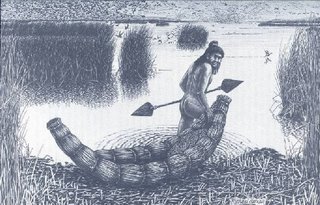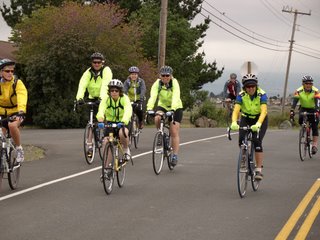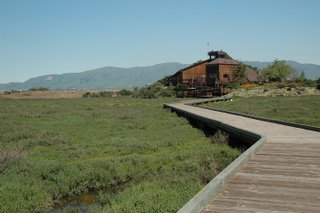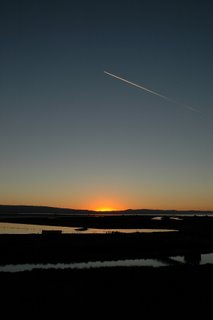20060927 Big Yellow Taxi Stops Near San Jose
20060927 Big Yellow Taxi Stops Near San Jose
The 1960s Joni Mitchell song Big Yellow Taxi lamented, "They paved paradise and put up a parking lot." This is the way it seems to go, usually. Once in a while though, the process is reversed.
 For hundreds of years the tidal salt marshes of south San Francisco Bay provided habitat for a multitude of living things, including humans. The Ohlone people not only harvested fish and wildlife from the area, they harvested salt. Later, European-descended people continued the salt tradition.
For hundreds of years the tidal salt marshes of south San Francisco Bay provided habitat for a multitude of living things, including humans. The Ohlone people not only harvested fish and wildlife from the area, they harvested salt. Later, European-descended people continued the salt tradition.
Commercial operations began in 1854. By the 1960s Leslie Salt had dissolved a number of smaller operators into one, with over 50,000 acres of salt ponds around the margins of San Francisco Bay. These ponds, separated from the tide by levees, allow for more efficient salt harvest than the natural marsh. The ponds, while not natural, did provide benefit to some species. See http://www.johncangphoto.com/articles/saltpond.htm for a summary of the situation and some excellent photos.
Leslie and its successor Cargill have sold some of the ponds to the San Francisco Bay National Wildlife Refuge and the State of California. The Refuge and its partners seek to restore many of the salt ponds to natural tidal marshes and have already been successful with a few.
The Refuge and its partners seek to restore many of the salt ponds to natural tidal marshes and have already been successful with a few.
In a region containing some of the highest land values in the country, I find this restoration simply amazing. In the 1960s an entire west bay community, Foster City, was created from salt ponds using dredge fill. This process could have been repeated decades later for a tremendous profit. Instead, one by one several of the ponds are being opened to the tide once again.
Instead, one by one several of the ponds are being opened to the tide once again.
 The general public benefits from the Refuge and its neighbor to the north, Coyote Hills Regional Park. A network of biking/hiking trails links the two and provides miles of much needed outdoor recreation in a densely populated area.
The general public benefits from the Refuge and its neighbor to the north, Coyote Hills Regional Park. A network of biking/hiking trails links the two and provides miles of much needed outdoor recreation in a densely populated area.
 The US Fish and Wildlife Service would like the public to understand that the Refuge has more than just recreational significance.
The US Fish and Wildlife Service would like the public to understand that the Refuge has more than just recreational significance.  The Fremont headquarters and visitor center tells the restoration story to the general public while a few miles away in Alviso local students participate in environmental education programs.
The Fremont headquarters and visitor center tells the restoration story to the general public while a few miles away in Alviso local students participate in environmental education programs. For the past couple of years Tia has been involved in the former and soon will switch to the latter.
For the past couple of years Tia has been involved in the former and soon will switch to the latter.
 Staff generally lives offsite, but some do live in "Trailerville," a motley collection of travel trailers and modular houses set in the headquarters maintenance yard. Tia lives there in what she calls her "tuna can", a thirteen-year-old 36’ Dutchman trailer.
Staff generally lives offsite, but some do live in "Trailerville," a motley collection of travel trailers and modular houses set in the headquarters maintenance yard. Tia lives there in what she calls her "tuna can", a thirteen-year-old 36’ Dutchman trailer.
Between park service seasons this "wildlife island in a urban sea" has become my refuge. After over four months in the Alaska bush, full on city life could be a shock. I am grateful that the Big Yellow Taxi stops here.
I am grateful that the Big Yellow Taxi stops here.
The 1960s Joni Mitchell song Big Yellow Taxi lamented, "They paved paradise and put up a parking lot." This is the way it seems to go, usually. Once in a while though, the process is reversed.
 For hundreds of years the tidal salt marshes of south San Francisco Bay provided habitat for a multitude of living things, including humans. The Ohlone people not only harvested fish and wildlife from the area, they harvested salt. Later, European-descended people continued the salt tradition.
For hundreds of years the tidal salt marshes of south San Francisco Bay provided habitat for a multitude of living things, including humans. The Ohlone people not only harvested fish and wildlife from the area, they harvested salt. Later, European-descended people continued the salt tradition.Commercial operations began in 1854. By the 1960s Leslie Salt had dissolved a number of smaller operators into one, with over 50,000 acres of salt ponds around the margins of San Francisco Bay. These ponds, separated from the tide by levees, allow for more efficient salt harvest than the natural marsh. The ponds, while not natural, did provide benefit to some species. See http://www.johncangphoto.com/articles/saltpond.htm for a summary of the situation and some excellent photos.
Leslie and its successor Cargill have sold some of the ponds to the San Francisco Bay National Wildlife Refuge and the State of California.
 The Refuge and its partners seek to restore many of the salt ponds to natural tidal marshes and have already been successful with a few.
The Refuge and its partners seek to restore many of the salt ponds to natural tidal marshes and have already been successful with a few.In a region containing some of the highest land values in the country, I find this restoration simply amazing. In the 1960s an entire west bay community, Foster City, was created from salt ponds using dredge fill. This process could have been repeated decades later for a tremendous profit.
 Instead, one by one several of the ponds are being opened to the tide once again.
Instead, one by one several of the ponds are being opened to the tide once again. The general public benefits from the Refuge and its neighbor to the north, Coyote Hills Regional Park. A network of biking/hiking trails links the two and provides miles of much needed outdoor recreation in a densely populated area.
The general public benefits from the Refuge and its neighbor to the north, Coyote Hills Regional Park. A network of biking/hiking trails links the two and provides miles of much needed outdoor recreation in a densely populated area. The US Fish and Wildlife Service would like the public to understand that the Refuge has more than just recreational significance.
The US Fish and Wildlife Service would like the public to understand that the Refuge has more than just recreational significance.  The Fremont headquarters and visitor center tells the restoration story to the general public while a few miles away in Alviso local students participate in environmental education programs.
The Fremont headquarters and visitor center tells the restoration story to the general public while a few miles away in Alviso local students participate in environmental education programs. For the past couple of years Tia has been involved in the former and soon will switch to the latter.
For the past couple of years Tia has been involved in the former and soon will switch to the latter. Staff generally lives offsite, but some do live in "Trailerville," a motley collection of travel trailers and modular houses set in the headquarters maintenance yard. Tia lives there in what she calls her "tuna can", a thirteen-year-old 36’ Dutchman trailer.
Staff generally lives offsite, but some do live in "Trailerville," a motley collection of travel trailers and modular houses set in the headquarters maintenance yard. Tia lives there in what she calls her "tuna can", a thirteen-year-old 36’ Dutchman trailer.Between park service seasons this "wildlife island in a urban sea" has become my refuge. After over four months in the Alaska bush, full on city life could be a shock.
 I am grateful that the Big Yellow Taxi stops here.
I am grateful that the Big Yellow Taxi stops here.
.jpg)

0 Comments:
Post a Comment
<< Home